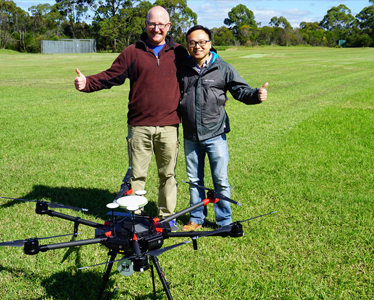Small partnership brings huge success

Four years ago, Dr Johnson Shen had a casual conversation with a UNSW alumnus. This little chat blossomed into a research and industry practice project that is helping to revolutionise the construction industry in Australia. Construction productivity is about cost, time, sustainability and safety. Some of the main challenges in construction surveying are: producing end-of-month volumetric measurements for project management, the extremely narrow timeframe for conducting site surveying, hazardous working environments and the dire shortage of skilled surveyors.
Dr Johnson Shen has partnered with local surveying firm Linke & Linke Surveys to develop Remotely Piloted Aircraft System (RPAS) using spinning Light Detection and Ranging (LiDAR) technology that delivers fast, accurate, real time 3D maps of targeted areas. As Director of Linke & Linke, James Linke notes, “Engineering is moving towards real-time reporting. Information that’s two days or two weeks old is not as valuable anymore.” Weighing just twelve kilograms, the small RPAS can travel for up to thirty minutes above any terrain, gathering data at millions of points per second and intensifying accuracy with every subsequent sweep. Cost savings are enormous and can be in the region of three thousand per cent when compared with one surveyor gathering the same amount of data.
While the “super drone” is not a cure-all or magic panacea – there will always be some construction or land surveying tasks which require higher fidelity techniques and methodologies – it does meet an extraordinary amount of construction and surveying challenges. It reduces cost and time enormously. It reduces the risks a surveyor might face in the field or onsite. It allows surveyors to meet deadlines whilst maintaining quality and accuracy. It fills a gap in an industry in need of more surveyors.
But perhaps more than anything it propels surveying and construction practices forward into a future with unlimited applications and possibilities. As Dr Shen says: “Drone technology is quite generic so it can be useful in many industries. For instance, it can be used on farms, assessing bio mass.” It can be used to assess natural disasters. It can help predict bushfire likelihood by generating heat maps of bushlands.
This is a state-of-the-art technological development and Dr Shen and his Linke & Linke partners are at the forefront despite the company being an SME enterprise which has received only relatively small amounts of funding. It is an amazing achievement of collaboration and planning.
Engineering is moving towards real-time reporting. Information that’s two days or two weeks old is not as valuable anymore.
James Linke - Director of Linke & Linke Surveys
Dr Johnson Shen believes that ‘hard’ technological developments start with the ‘soft’ issue of relationship, mutual respect and shared understanding. “Industry engagement can start small, we build the relationship and the trust while we refine the scope of collaboration and customise our research to make the knowledge applicable. That is the beauty of industry and academic collaboration: universities bring an ever-developing body of expertise while industry puts it into practice.”
The mutual benefits of such collaborations have not always been recognised by the construction industry in Australia. Academics need to get the message out with constant and broadening forums of communication. Johnson believes listening is the most important part.
Dr Johnson Shen is an up and coming force in technology for engineering. His research interests include automation, robotics, RPAS and hybrid variations for longer endurance, Artificial Intelligence (AI), Internet of Things (IoT), virtual reality, mixed reality, remotely piloted ground vehicles to assist in indoor mapping… the list goes on.
As he notes, universities can provide industry with cutting edge research equipment and expertise. Our people are knowledgeable and committed to engendering new ideas that can solve industry problems. With technology like the “super drone”, productivity can increase exponentially.



